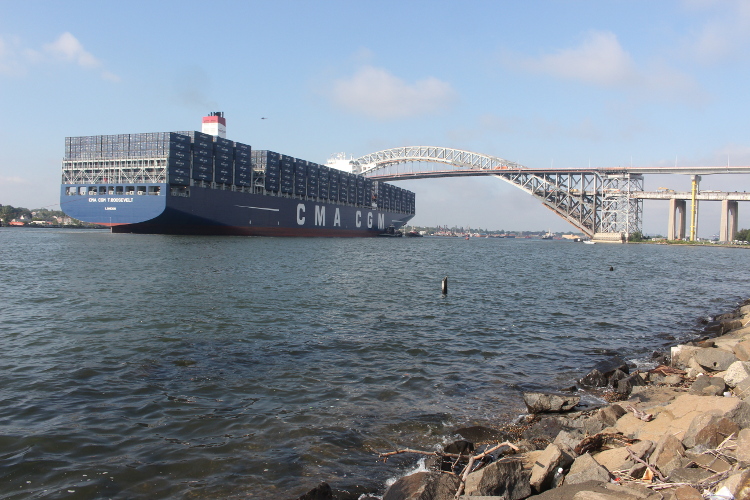Smooth sailing for NY-NJ’s first 14,000-TEU service call
Hugh R. Morley, Senior Editor | Nov 22, 2017 5:15PM EST
 Interested in sharing JOC.com content? Please view our current Copyright and Legal Disclaimer information, as well as our Frequently Asked Questions to ensure proper protocol is followed. For any questions, contact the Customer Support team at our Help link.
Interested in sharing JOC.com content? Please view our current Copyright and Legal Disclaimer information, as well as our Frequently Asked Questions to ensure proper protocol is followed. For any questions, contact the Customer Support team at our Help link.
The 14,400 CMA CGM T. Roosevelt approaching the Bayonne Bridge in a test run in September. The megavessel was the first of that size to make the run in service this week. Photo credit: Hugh R. Morley
The Port of New York and New Jersey hosted its first 14,000-TEU ship on a regular service without a hitch Tuesday, five months after the opening of the elevated Bayonne Bridge, in a sign of the steady increase in the size of vessels coming to the port.
About 50 ships that could not have in the past passed under the bridge have now done so, the Port Authority of New York and New Jersey said. Fourteen percent of the ships that entered the port in 2017 could carry 9,000 TEU or more, compared to 9 percent in 2016.
The visit of the 14,400-TEU CMA CGM T. Roosevelt — which arrived at Maher Terminals in Elizabeth at about 10 a.m. Tuesday and was expected to leave Wednesday evening — comes as the port waits to see the long-term impact on port volumes of the elevation of the bridge, and the expansion of the Panama Canal a year earlier.
Figures released Wednesday show that October capped the port’s best six-month period in its history, the authority said. The port in October handled 408,764 loaded TEU, with loaded imports increasing by 5.8 percent over the same month in 2016, and exports increasing by 1.3 percent.
Yet the port is struggling to hold onto its market share, which has declined steadily since 2010. In the third quarter, the port’s share of loaded imports on the East Coast fell by 0.44 of a percentage point, to 34.3 percent, over the same quarter in 2016, according to PIERS, a sister product of JOC.com within IHS Markit. The port’s export share ticked up by 0.14 of a percentage point to 21.2 percent, and the port’s share of both stayed about the same as in 2016, at just over 29 percent.
Some port stakeholders have questioned whether the port — and other ports — can handle the kind of sustained stress on equipment, resources and the drayage community that is expected when big ships come into the port on a regular basis. But port officials said the Roosevelt docked and unloaded largely without equipment logjams or truck congestion.
“There haven’t been any issues at all,” said Beth Rooney, the port’s assistant port director. She added, however, that “the reality is that until you start seeing these larger vessels as the workhorse, until most of the vessels are probably about 12,000 TEU or larger, I don’t anticipate that we would have a problem.”
Bruce Fenimore, CEO of Columbia Container Services, which opened a new chassis yard close to Maher Terminals three weeks ago, said late Tuesday that the yard had “no issues at all” from the ship’s arrival. “We had plenty of chassis.”
A representative of Maher Terminals wasn’t available for comment.
CMA CGM added the Roosevelt, which docked at the port in July for a publicity event, to its South Atlantic Express route from China via the Panama Canal, which previously stopped only at Charleston, Norfolk and Savannah. The weekly route includes two 14,400-TEU vessels, the other is the CMA CGM J. Adams, and the rotation is rounded out with 10,000-TEU ships.
“Ever since the announcement at the inauguration of the Bayonne Bridge that the CMA CGM T. Roosevelt, and our other ships with 14,000-TEU capacities, would call New York/New Jersey on the South Atlantic Express (SAX), interest in the service has steadily grown,” Marc Bourdon, President, CMA CGM, said in a statement released by the carrier.
Although CMA CGM has three other routes to New York and the East Coast, the SAX route provides an “advantageous alternative,” offering additional flexibility with different port calls and sequences on routes from China, he said.
No other regular service calls the port with ships of 10,000 TEU or above, although the overall size of ships coming to the port continues to increase, Rooney said. The percentage of ships that are 8,000 TEU or above rose from 43 in the first nine months of 2016 to 56 percent in 2017.
Until June, vessels of more than 9,500 TEU were unable to pass below the Bayonne Bridge, which prevented them reaching three of the port’s four main terminals – Maher, APM Terminals and Port Newark Container Terminal. The only terminal that could handle them was GCT Bayonne.
The port embarked on the $1.6 billion project to elevate the bridge’s roadway, from 151 feet to 215 feet, as part of its effort to prepare for mega-ships, many of which are expected to come through the Panama Canal. The canal was expanded in June 2016 so that it could accept vessels up to 14,000 TEU, compared to 4,500 to 5,500 TEU before the upgrade.
The port authority and federal government have spent $4.7 billion on dredging, rail access, and other projects, including raising the Bayonne Bridge, and GCT Bayonne has introduced an appointment system to smooth the flow of trucks in and out. Other efficiency moves planned, such as a port-wide chassis pool and extended gate hours, have yet to materialize
No comments:
Post a Comment